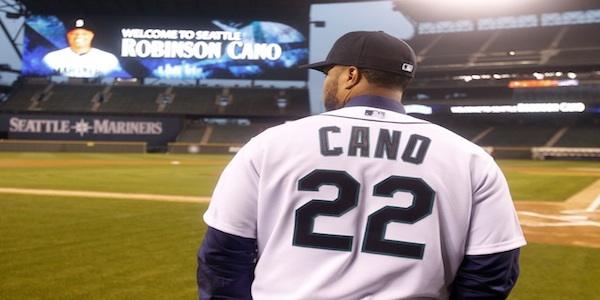Fantasy Baseball: A look at HR surgers and shrinkers
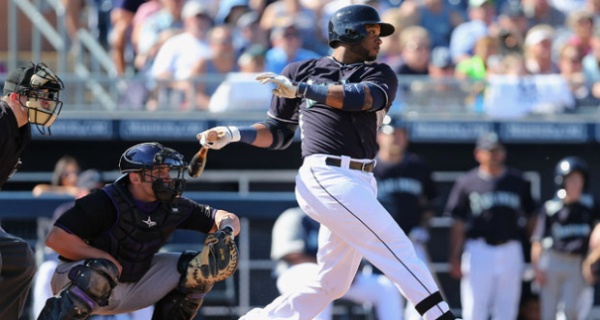
For many players in season long roto leagues, you are beginning to make trades to fill holes in your squad. One of the joys of rotisserie scoring is that you can target one (or more) categories that will have the most significant impact on your point total. I like to target counting categories (like HRs or SBs) when I’m trying to move up.
For me, that category was HRs – in one 5×5 mixed league with 35 man rosters and a limit of only 8 transactions (add/drops) per season, trades are the key to success. In that league second place has 107 HRs and tenth has 95. This is a category where one well-timed trade could mean a gain of five or more points.
Below you will find some targets (and some players to avoid or perhaps include in deals) who are projected to provide more (or fewer) HRs for the rest of the season than they have up to this point.
Methodology
I ran two separate leaderboards from FanGraphs – the first showing all qualified hitters for 2014 so for and then all qualified hitters for the prior three years combined (2011 through 2013). Then, I took the current 2014 HR/FB% and compared it to the three year average for HR/FB% for players who were in both lists.
It’s important to remember this won’t capture everyone – only those who had enough plate appearances to qualify for the batting title over the periods I surveyed. So, you won’t find Jose Abreu’s otherworldly 35.1% HR/FB rate here because we don’t have any MLB data to compare.
Surgers
First, let’s take a look at those hitters who seem to be under performing in the HR category. The chart below shows those players who are five percentage points or more below their last three years’ average HR/FB rate.
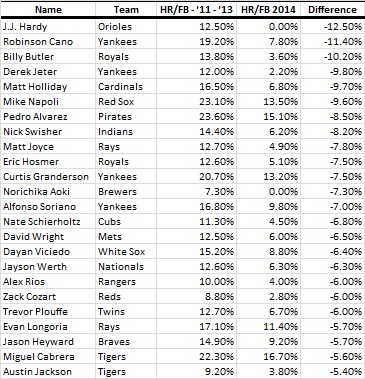
Let’s look at a few of the more interesting names – I won’t cover everyone on this list, but the list should be a good starting point to target hitters should you need HRs in your league.
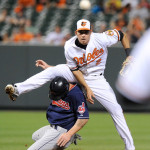 J.J. Hardy hasn’t hit a HR yet this season after hitting 77 over the last three years. However, this isn’t a “new” trend per se. From August 19 to the end of last season he hit only three in 158 plate appearances (one HR every 53 PAs) after hitting 22 in his first 486 (one HR every 22 PAs).
J.J. Hardy hasn’t hit a HR yet this season after hitting 77 over the last three years. However, this isn’t a “new” trend per se. From August 19 to the end of last season he hit only three in 158 plate appearances (one HR every 53 PAs) after hitting 22 in his first 486 (one HR every 22 PAs).
There is nothing in his batted ball profile to suggest Hardy has changed the way he hits the ball – he has a few more infield fly balls, but nothing egregious.
I chose the 19th of August because Hardy had just sat out a couple of games with back spasms. There was no mention of any issues for the rest of the year. However, Hardy struggled again in early April with back and neck issues and has had some hamstring issues lately.
I don’t think he’ll stay at zero HRs for the year, but be aware of his lingering injuries when considering the rest of season projections of 9 and 10 HRs from ZiPS and Steamer respectively.
Robinson Cano’s move to Seattle had many concerned prior to the season that we’d see a drop off in power with the impact Safeco has on right handed power. However, I don’t’ believe anyone predicted Cano would have just four HRs through nearly 300 plate appearances after five straight seasons of 25 or more.
Cano’s batted ball profile this year raises the first red flag as his ground ball to fly ball (GB/FB) ratio is 2.51 this year (career 1.58) and he’s hitting more than 50% of his batted balls on the ground. It’s tough to hit a home run via a ground ball.
He’s been nearly injury-free during his career so unless he’s hiding something injury is proably not the reason for the drop. He’s not been a total loss as he’s still hitting, just not for power. Steamer has him at 15 HRs for the rest of the season, ZiPS at 10. I’d lean more towards the ZiPS number than the Steamer one, but he’s a target for power in the second half.
Matt Holliday has seen his HR/FB rate drop each of the last three seasons (from 18.5% to 16.4% to 15.0% last year). He’s currently at 6.8% – easily the lowest of his career. In May, Mike Podhorzer said not to worry as Holliday’s HRs were down, but the distance of HRs was up. More dingers would come. Since May 12, he’s hit three HRs so we haven’t seen a big uptick. What gives?
Holliday’s batting ball profile doesn’t show anything worrisome. He did have some back issues near the end of 2013 and early in June of this year, but there didn’t seem to be anything to it. He is 34 so he’s certainly on the downside of his career, but this drop off seems a bit too precipitous.
He has been a better hitter in the second half in his career (though there isn’t really a thing as a first or second half hitter). He’s got .942 OPS in the second half versus .888 in the first half for his career. He has 128 HRs in each half for his career, but in 830 fewer plate appearances in the second half.
He’s still hitting in the middle of the Cards’ lineup so the opportunities will be there when the power comes – at it will. Steamer has him with 10 more HRs this year and ZiPS has him with 11. I’d pay full price for those projected HRs.
And now a few quick hits on others on the list:
Billy Butler’s two HRs are just a bit too low for someone who brings almost no other skills to the diamond. This decline in power started last year as his batted ball profile changed considerably. His GB/FB ratio was over two and his GB% was above 50%.
He’s continued the trend into 2014, but his HR/FB rate is a putrid 3.6% so he’s not quite that bad. I think we’ll see 2012 as the outlier year for Butler (19.9% HR/FB, career 11.0%). I imagine Butler gets back close to that 11% number once the season is done, but his decline is real – he’s slowly turning into Casey Kotchman without the defense. ZiPS has nine more HRs for him and Steamer has 10 – I’d probably take the under.
Nick Swisher was one of my favorite sleepers coming into the season. He’s been disappointing and injured (with knee issues) for most of the season. Now, with the hope that he’s fully healthy, we could see a surge in power.
His batted ball profile this year shows a much higher infield fly ball % (15.4% versus 9.6% for his career), but that increase comes almost completely from a reduction in groundballs. He’s hitting more balls in the air than he has since 2010, but a paltry 6.2% HR/FB ratio has him stuck on four (ed. now five HRs with his walkoff grand slam on Thursday).
Steamer says nine more HRs and ZiPS agrees. Make that three in agreement with that number – he’s a target who likely won’t cost much.
Shrinkers
And now, the list of those who are five percentage points or more above their last three years’ average HR/FB rate.
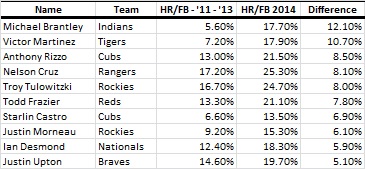
The list is much shorter than our surger list so let’s take a look at who we should sell? Or perhaps whose surge we should believe in for the year.
Michael Brantley is having a breakout season for Cleveland. He’s already hit more HRs (11) this year than he had all of last year (10). He’s seen improvements in his BB% and K% all while maintaining a BABIP (.329) not that far head of his career (.307).
His batted ball profile has changed slightly with him hitting a few more ground balls this year forsaking some flyballs. However, he’s poking 17.7% of those flyballs out of the yard (compared to a career average of 6.4%). Again, Mike Podhorzer comes to the rescue and notes that Brantley is (as of a month ago) hitting his HRs farther.
However, the jump is just too large for Brantley to sustain – his minor league profile has no evidence of this skill. Based on last year’s leader board, that rate would put him near David Ortiz, Justin Upton, Jose Bautista, Ryan Zimmerman and Edwin Encarnacion. A nice neighborhood, but Brantley isn’t likely to be able to take up residence there.
ZiPS has Brantley for seven more dingers and Steamer says six. That seems about right – he won’t keep this pace up the rest of the season.
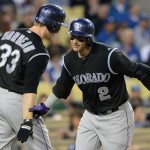
Troy Tulowitzki and Justin Morneau both play for the Colorado Rockies so let’s put them together (for more than the shared clubhouse). For both Tulo and Morneau, the biggest positive this season is health. Both are fully healthy for the first time in a couple of years. For both, that has been the key to unlock the skills they’ve shown in the past.
Tulo hasn’t shown any significant change in his batted ball profile. He had an outlier season of 13.3% HR/FB in 2012 and that drags his three-year average down a bit. Outside of 2012 he’s been around 17% to 18%. ZiPS projects him for 16 more HRs and Steamer has him at 17 for the rest of the year. That would give him a career high and if his health holds that’s probably the floor for Tulo.
Morneau looks to be finally healthy after struggling to recover from two concussions and a series of nagging injuries. He’s HR/FB is out of line with his last three years, but in line with the rest of his career. He looks like a great buy high candidate as his health looks to have been what was holding him back the last few years.
The one concern is his batted ball profile as he’s got a 1.51 GB/FB rate (career 1.02) and is hitting the fewest flyballs of his career since his rookie season in 2003. ZiPS has him at 10 more HRs this year and Steamer has him at 12 – I think he’s got a chance to finish with a couple of more than that as he is back to full health.
Victor Martinez’s recovery looks similar to Morneau’s as he’s looks to be fully recovered from his missed 2012 season. His HR/FB rate of 17.9% would be a career high if he hangs out. He won’t, but his dropoff may not be as huge as it might seem based on his last couple of seasons.
I can see him settling around 11% to 12% HR/FB rate for the remainder of the season and meeting his ZiPS and Steamer projections of 11 HRs for the rest of the season. He’s DH-ing regularly so his health shouldn’t be as much of an issue as it was when he was catching. As with Morneau, Martinez’s health has unlocked his true skill set.
Starlin Castro’s power does not look like it can be maintained. Yes, he’s still young (24), but the leap he’s made it the mid-double digits is far outside of anything he’s shown in the majors (career 6.7% HR/FB rate) or minors (7 HRs in 845 PAs). ZiPS has him with nine more HRs and Steamer is at 7, but I’d take the under on both of those for the rest of the year.
Hopefully you can target one or more of these players in your midseason deals to help you move up in HRs and ultimately win your league’s title.
Thanks to FanGraphs for the 2014 and 2011 through 2013 leader boards used for this post. Thanks to RotoWire and Baseball Prospectus for injury information. All statistics are through Wednesday 19 June 2014





